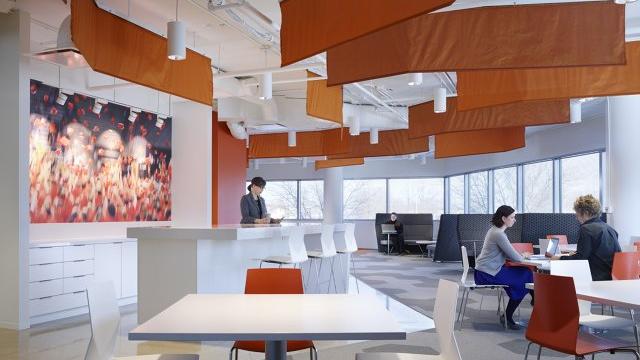From: bizjournals.com
Amid the constant debate about workplace design and the merits of cubicles and open-office layouts, it’s imperative we don’t lose sight that there are proven strategies to help organizations create workplaces that both empower people and drive business.
Leaders truly seeking to strengthen their business need to leverage workplaces as tools to improve their organization.
Merging business goals with design thinking and careful research can absolutely improve communication, innovation, employee engagement, culture and other performance metrics.
Several organizations are currently investing the time and research necessary to drive this transformation.
Here is a look at four key steps every organization should be considering.
1. Research
There is no way to develop a strategic workplace without fully understanding the organization that will use it through extensive research. Organizations need to commit to fully exploring their culture, aspirations, values, brand, current work realities, and future work aspirations on every level. This research will inform design decisions that evolve the work environment to improve the lives of employees and fit the organizational culture. Those organizations willing to ask those hard questions undoubtedly gain strategic insight and key data relative to their business.
2. Strategy
Data is only powerful if it is then leveraged into design solutions. After collecting extensive data from its employees in advance of the creation of a new headquarters, Follett created an innovative new workplace that consolidates three previously separate facilities.
“We sought an environment that could not only just contain how work gets done, but be a catalyst [to evolve] the business,” says Follett CEO Mary Lee Schneider. Follett’s research revealed critical insight that needed to be addressed by the new headquarters including:
- Only 45 percent of Follett’s employees were happy with the previous offices. This is 25 percent below the average American workplace score of 60 percent satisfaction.
- Sixty-five percent of Follett employees said they’d take advantage of alternate places to work away from their desks if available.
- The previous offices offered just four meeting rooms for every 100 employees (the new headquarters offers 11 to every 100)
Follett listened to its employees and changed these realities through the creation of a headquarters with different workplace settings integrated into neighborhoods. At the center of each floor — linking the company’s space in the tower — is a hub of flexible workspace. Each hub has a unique character to give floors identity while also responding to collaborative work that may take place. Ultimately, the typical floor offers 10 different types of settings to choose from and encourages communication, collaboration and employee experience.
3. Change management
It’s also key for organizations to understand that simply creating a workplace and opening the doors to employees isn’t enough to ensure successful adoption and transformation. Workplace changes should be guided by comprehensive change management programs including a communications and engagement schedule, manager meetings and employee training. With Follett, every employee received a Change Management Playbook that responded to FAQs and also detailed the benefits and advantages of the new headquarters and its spaces.
4. Measure
Organizations making significant change to their workspaces should also commit to performance measurement. Our team encourages those we work with to measure six months after opening to understand the impact the new workplace is having on intended business results. That said, continually measuring and testing the workplace is a best practice organizations should invest in. The only way to have undeniable proof your workplace strategy is improving performance and employee experience is to point to new data.
There’s no one-size-fits-all solution for workplaces but there are real ways for organizations to improve their business through design. Those organizations that recognize the value of research, strategy, change management and measurement will best position themselves moving forward.








Leave a Reply
You must be logged in to post a comment.